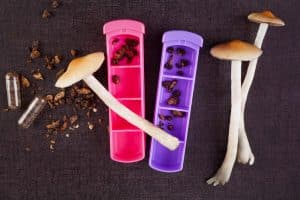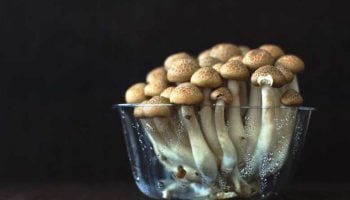
Disclaimer: Psychedelics are largely illegal substances, and we do not encourage or condone their use where it is against the law. However, we accept that illicit drug use occurs and believe that offering responsible harm reduction information is imperative to keeping people safe. For that reason, this document is designed to enhance the safety of those who decide to use these substances.
Disclosure: This article contains offers and affiliate links. Third Wave receives a small percentage of the product price if you purchase through affiliate links. Read our ethics and affiliates policy here.
In her book, A Really Good Day, author Anne Waldman described her first microdosing day using lysergic acid diethylamide (LSD):
“I feel happy. Not giddy or out of control, just at ease with myself and the world. When I think about my husband and my children, I feel a gentle sense of love and security. I am not anxious for them or annoyed with them,” she says.
“When I think of my work, I feel optimistic, brimming with ideas, yet not spilling over.”
Microdosing is the act of taking low doses of psychedelics or plant medicine to benefit from their physiological action while minimizing undesirable side effects.
Given the potential to enhance mood, cognition, energy, sociability, and overall well-being, you may be wondering how can you make the most out of microdosing’s effects?
Since microdosing is such a personal journey, no single answer suits everyone.
However, based on studies and personal stories, here’s some guidance on how you might best shape your microdosing day.
Why Microdose? Physical and Mental Health Benefits

Over recent years, the explosion in psychedelic research has seen more and more people experimenting with microdosing to support their health and wellness.
A brain imaging study led by Dr. Robin Carhart-Harris at Imperial College London found psilocybin, the active ingredient in “magic mushrooms,” altered the brain connectivity of treatment-resistant depression patients..
This ability to “re-shape” thought and behavior patterns is known as neuroplasticity and is thought to be an important mechanism in psychedelics’ healing and transformative effects.
Although most psychiatric studies focus on higher doses (for psilocybin, around 25 micrograms and above), microdoses of psilocybin mushrooms or LSD can also have positive effects on mental health.
For example, in one analysis of microdosing self-reports, researchers found microdosing could help decrease trauma, stress, anxiety, and substance abuse and increase positive mood.
However, since there is mixed evidence on whether microdosing is a placebo effect or not, microdosing isn’t generally recommended as a remedy for health issues. Rather, it is more often used as a means to create positive lifestyle changes and enhance daily life.
Microdosing’s day-to-day benefits can include:
- Improved energy
- Increased focus
- Increased self-awareness
- Improved sleep
- Physical energy
- Increased empathy
- Mood enhancement
By carefully planning your day, you can gain the most value from microdosing’s effects and increase the chance of creating long-lasting positive outcomes.
Based on his own microdosing experience, Third Wave CEO, Paul F. Austin, has created a five-pillar framework you can use to model your microdosing days and optimize your experience.
Check out the video above to hear what he has to say, or keep reading to learn more.
The Five Pillars of An Ideal Microdosing Day
Pillar One: Meditation

Because microdosing can often be stimulating, in some cases causing anxiety, meditating in the morning can help ground you before its energizing effects kick in.
A morning meditation practice can also offer greater clarity going into the day ahead, enhancing microdosing’s potential self-awareness and insight benefits.
Moreover, since psychopharmacology and brain imaging research have found that meditation and microdosing can both increase neuroplasticity, combining both practices could have a synergistic effect.
If you’re new to meditation, you might start off with a short practice (say, five minutes) and gradually increase the length of time. There are also different types of meditation, such as mindfulness, compassion-based, and mantra, so we recommend trying out different ones and deciding which are the best for you.
Pillar Two: Workflow

In a recent Third Wave podcast episode, psychologist and author of The Psychedelic Explorer’s Guide, Dr. James Fadiman, described how psychedelic drugs can bring about “mental magic,” recounting their ability to increase focus, creativity, and problem-solving ability. These effects have led to the growing microdosing trend among Silicon Valley entrepreneurs.
Demonstrating these potential cognitive effects, one study showed how microdosing psilocybin mushrooms increased both convergent and divergent thinking in participants.
As these mental processes are key for solution-finding and creative thought, you can take advantage of this cognitive boost by working on mentally demanding tasks and projects during microdosing days.
We recommend sticking with one project you can completely immerse yourself in, since microdosing can induce flow states, putting you “in the zone.”
It’s also best practice to choose an environment conducive to work, free of distractions, and plan what you will work on in advance, so you can completely dive into the project without worrying about what to do first.
Pillar Three: Self-care

With microdosers self-reporting increased energy, stamina, and body awareness, you may dedicate time during your microdosing day to some form of exercise.
Since microdosing is an opportunity to build healthy habits, exercising during microdosing days could help you make this part of your daily routine and improve your overall fitness.
Depending on your preferences, baseline fitness, and mood during that particular day, you could choose anything from a gentle yoga practice to a high-energy CrossFit class.
In addition to exercise, it’s important to tend to your health by fueling your body with nourishing and healthy food during microdosing days.
For detailed nutritional advice to aid your microdosing journey and other personalized, in-depth resources to optimize your experience, be sure to check out our microdosing course.
Pillar Five: Self-reflection

At the end of a microdosing day, you may want to ask yourself questions such as:
- What has my general emotional state been today?
- What activities have I benefited from?
- Which activities didn’t benefit me, and what might I change for next time?
- Do I feel closer to my goals?
By reflecting on your challenges and achievements, you can start to integrate your microdosing experience and better navigate your journey going forward
For professional support to help you process and guide your experiences, you may want to check out our directory of psychedelic therapists and coaches.
Microdosing Psilocybin Mushrooms vs. LSD

Variations in effects between different psychedelic drugs mean it’s good to plan your day with your medicine of choice in mind.
For instance, our program participant research found that, while LSD was generally better for problem-solving, psilocybin mushrooms were generally better for creativity.
Therefore, if LSD is your substance of choice, you may be better off choosing more logical and cognitive work tasks to engage with. On the other hand, if you’re microdosing psilocybin mushrooms, you may opt for more flexible, artistic projects.
When microdosing LSD, since its effects tend to be more stimulating, you may also plan for more energy-consuming activities than if you’re microdosing other psychedelic substances.
Although LSD and psilocybin mushrooms are the most popular psychedelic medicines for microdosing, people microdose with a range of substances, including other classical psychedelics, like mescaline and DMT, and non-classical psychedelics, such as MDMA and cannabis.
If you’d like to learn more about the differences between different compounds to plan your microdosing days in accordance with their varying effects, check out our psychedelic substances guide here.
Disclaimer: Third Wave does not encourage illegal behavior. Make sure you are aware of the legal status of your microdosing substance of choice before purchasing or growing such compounds.
Things to Avoid on Microdosing Days

Because of microdosing’s stimulating effects, it’s best not to take other energizing supplements, such as caffeine, on microdosing days, as this could increase the chance of overstimulation and anxiety.
Since psychedelics can make people more open and attuned to their surroundings, we also recommend avoiding environments that make you feel uncomfortable, such as overly crowded and stimulating places, as these could increase the chance of distress and overwhelm.
Furthermore, since several studies, such as a recent trial from New York University, have found psychedelics can help people overcome dependence, you can use these days as windows of opportunity to avoid things you’d like to give up, such as alcohol or smoking.
Remembering Your Intention
In a systematic microdosing study published in the journal Plos One, researcher Vince Politio found that participants’ expectations before microdosing were unrelated to their outcomes. These findings demonstrate how microdosing can sometimes give rise to unpredictable effects, both beneficial and not.
However, by determining precisely what you’d like to achieve from microdosing and planning your day in line with these goals, you can help improve the chance for desired outcomes.
So, even though this article covers some general pillars for optimizing a microdosing day, what’s most essential is that your journey remains tailored to your personal needs, preferences, and intention.
If you’re interested in detailed, science-led education on how to microdose to meet your individual goals, make sure you check out Third Wave’s Microdosing course. Our customized guidance is designed to help you best achieve healing, peak performance, and personal growth, with results that last.







